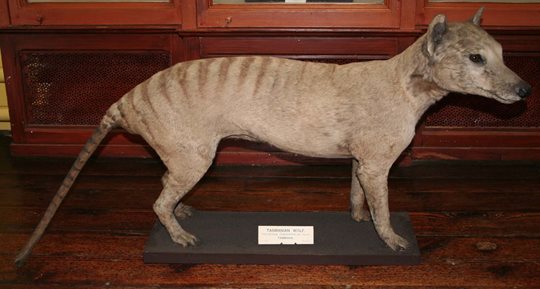Acquired in 1917
Thylacine: An extinct marsupial from Tasmania
The thylacine is an extinct species of marsupial mammal, formerly found in mainland Australia and later confined to Tasmania. It is commonly known as the ‘Tasmanian tiger’ or ‘Tasmanian wolf’.
by Leona McArdleRegister entry and description
The original museum register entry for this specimen reads:
“Tasmanian Wolf [symbol for male] skin & bones (Thylacinus cynocephalus); bought from Prof. J.T. Flynn Hon. Curator Museum & Art Gallery Tasmania; £35--; Tyena District, Tasmania; Ordered by Dr. Scharff during his visit to Australia, 1914. Obtained by Mr. R.H. Waterworth, Hobart, Tasmania. Now almost extinct. See File 473.1914. Sent to Rowland Ward to mount”
The coat of the specimen is coarse, with short hair and is light in colour (due in part to fading over time) with a series of darker stripes running across the back and around the tail. The tail is elongate and stiff.
Biology and extinction
The thylacine was a carnivorous, marsupial mammal found in Australia. Its scientific name is Thylacinus cynocephalus, meaning ‘dog-headed pouched dog’. It bore a superficial resemblance to tigers (dark stripes across its back) and wolves (shape of the skull). However, as marsupials, thylacines were not closely related to placental mammals such as tigers or wolves, but their physical similarities were as a result of occupying similar ecological niches, a process known as convergent evolution.
Thylacines, like other marsupials, possessed a pouch on the underside of the body but unusually the pouch was present in both males and females. The female pouch opened to the back (a kangaroo pouch opens to the front), and could accommodate up to four babies, who would continue their development following birth. The babies lived in the pouch for about 3 months, which extended in size to accommodate the growing babies. After this time, the young thylacine lived outside the pouch in a cave where they would be semi-independent and continue to be fed by the mother until they were old enough to hunt. The preferred prey of thylacines was thought to be wallabies and small mammals.
The arrival of European settlers had a detrimental effect on their populations. New communities were set up, introducing sheep and dogs, and encroaching on large portions of the thylacine’s natural habitat, pushing out its natural prey. Soon large numbers of sheep were dying and thylacines were quickly deemed a pest species. However, the actual numbers of sheep killed by thylacines were greatly exaggerated by landowners who attributed all sheep deaths to these animals. In reality, factors affecting the numbers of sheep were: inappropriate choice of land, weather, poor management of flocks and predation by feral dogs. Bounties were introduced in 1830 allowing landowners to shoot these animals with a price of between 10 shillings and £1 on their head. These bounties, which lasted until 1909, sounded the death knell for these mainly nocturnal animals. By 1909, over 2000 bounties had been paid out.
By this time, thylacines were becoming quite rare and so, museums and zoos were interested in obtaining specimens for display before it was too late. Live animals were captured and sent to zoos all over the world. By 1933, the thylacine was so rare that finally there were active discussions in parliament about re-evaluating the ‘unprotected’ status of thylacines. The last thylacine captured in the wild, known as ‘Benjamin’, was sent to Hobart Zoo in 1933. However, his presence in the zoo was short-lived and he died shortly afterward on the 7th Sept 1936. Despite numerous expeditions and surveys to seek out hidden populations or even individuals of thylacines in Tasmania, there has been no physical trace of the thylacine. So in 1986, the thylacine was officially classified as presumed extinct as it hadn’t been seen in the wild for 50 years.
About our specimen
In 1914, Dr R.F. Scharff was the Keeper of Natural History in the National Museum of Ireland. He attended a scientific meeting in Australia, and while there sought the help of Professor T.T. Flynn, a renowned biologist and the curator of the Tasmanian Museum and Art Gallery, to secure a new thylacine specimen for the Dublin museum. In light of their decreasing numbers, they wanted to replace the existing specimen as it was in poor condition. The challenge was accepted and Professor Flynn (father of 1930s swashbuckling actor Errol Flynn) mounted an expedition “at great expense to the Tasmanian Museum”. However, that expedition was unsuccessful and a trained hunter was recruited to capture the elusive animal. Finally an adult male was captured in the Tyenna district of Tasmania, and the skin and bones of the animal were shipped to Dublin, arriving at the museum in 1917. The specimen was sent to Rowland Ward to be prepared as a mounted taxidermy specimen and put on display.

Learn more
This specimen and skeletal forms of the thylacine can be seen in the Mammals of the World gallery on the first floor of the National Museum of Ireland – Natural History, along with examples of its closest living relatives: numbats and Tasmanian Devils.
References
Paddle, R. (2000). The last Tasmanian tiger: the history and extinction of the thylacine. Cambridge University Press.
‘The Thylacine’ online at The Australian Museum
* With thanks to Nigel Monaghan for providing comments and images.
Location:
Thylacine: An extinct marsupial from Tasmania is located at:
On Display
Previous artefact:
Three Young Lizards from Cappagh, Co. Waterford
Next artefact:
Tin Objects Made by Donegal Traveller and Musician
